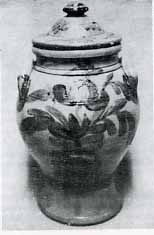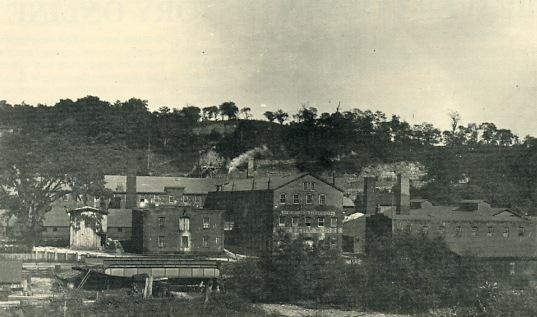
An Unusual form of stoneware is this three gallon water fountain or cooler made by R. W. Russell.
Click Here to Return To Milestones Vol 8 No 2
The first stoneware pottery manufacturing to take place in Beaver County was probablyt hat produced by James and William Hamilton, sons of a Moon Township (now Center Township) farmer, in the town of Bridgewater. The exact location of their operation is not known at the present time, but we do know that they obtained their clay from a hillside near the confluence of Brady's Run and the Beaver River, around 1840. This date can be confirmed by a listing in the 1841 Bridgewater Business directory showing James and William L. Hamilton as potters. The Hamiltons produced utilitarian salt glazed stoneware in the form of jars, crocks, and jugs decorated with cobalt blue flowers, vines and lined embellishments in the typical German or tutonic tradition. These products were often impressed "J. Hamilton Beaver Pa." with the "R" in Beaver upside down and reversed. The town of Beaver is used in the trademark because the post office was located there. Locating near a navigatable river was necessary for the easy movement of manufactured goods to prospective buyers along the Ohio and Mississippi River via the traditional flat boats. There seems to be no available production records to document the amount of stoneware produced by the Hamiltons while they were located in Bridgewater, but surviving examples of their products are highly sought after by today's collectors.
As time went on other clay deposits were discovered near the banks of the Ohio River in Boro Township near the town of Vanport. By 1849, there were six potters on the membership roles of the secret I.O.O.F., Bridgewater lodge. This increase in competition may have been what caused the Hamilton Brothers to seek a new location for their pottery at the town of Greensboro, Greene County, Pa., on the banks of the Monongahela River after 1850. What they left behind them was a tradition of craftsmanship that would be carried on for more than forty years here in the Beaver Valley.
Johnathan McKenzie first held a deed for property in Brighton Township in 1836. He was listed in early censuses as a farmer. His son William actually was the potter in the family, but the stoneware he produced was impressed, J. McKenzie, Beaver Pa. The products of the McKenzie firm followed the typical format of the middle nineteenth century potteries. Residents of the surrounding communities would purchase most of their eating, cooking and storage vessels directly from the pottery or from dry goods stores, as the potteries maintained both a wholesale and retail business. The common forms of stoneware vessels on hand would be jars, jugs, pitchers, water fountains, chamber pots, cream and butter pots, milk pans, fruit bottles and churns. The early McKenzie products were not elaborately decorated and usually had only a few leaves or a single flower decoration, although some highly decorated pieces are known to exist. The stoneware produced in the Beaver area was decorated with cobalt, which produced a bright blue color, and then glazed during the firing process. Salt obtained from the Industry area, was inserted into the kiln forming a glass-like coating on the outside of the vessel making it impervious to most liquids. The McKenzie kiln was located along Two Mile Run near the Boro Township line.
In 1845, Ralph Russell, a New York native, married Ellen McKenzie, Johnathan's daughter. Two years later, in 1847, Russell purchased property in Boro Township. It was probably at this time that he began to produce stoneware marked, R.W. Russell (with and without "Beaver Pa.") as his trademark. Many of the pieces produced by the Russell pottery were decorated with unusual leaf and flower designs sometimes coming from both sides of the piece and meeting in the center. The Russell pottery is shown on the map of Boro Township in the Caldwells Centennial Atlas of 1876. It was located near the confluence of Mudlick Creek and Two Mile Run. The R.W. Russell pottery continued operation until approximately 1869, when the elder Russell passed away and the operation was taken over by his son Albert. Albert Russell, who had started working at the pottery as a young boy, continued the operations as his father had taught him and was still making hand turned and decorated stoneware products in the late 1800's, many of which still turn up at local auctions.

As word traveled about the high grade fireclay deposits suitable for the manufacturing of stoneware in Boro Township and the ready access to salt, wood and transportation necessary for a profitably business, new potters began to relocate in Beaver County.
One such craftsman was John Weaver. He was first recorded as owning property in Brighton Township in 1855. The Weaver Pottery is shown on a 1869 map of Ohio River towns, on the west side of Mudlick Creek. The ware made by the Weaver pottery was some of the finest produced in Beaver County. The clay body was a bright grey and gave a perfect background for the application of cobalt slip in the typical flower design. Infrequently, unusual forms of trees and other whimsical displays such as a jug with freehand printing "OLD RYE" to herald its contents,do surface and are highly prized. These decorated containers were produced in the standard utilitarian forms previously mentioned. The Weaver pottery had one of the longest production records in the county, somewhere around forty years. George Weaver, worked with his father at the pottery. As of this writing, the only trademark known for the Weaver Pottery is an impressed J. Weaver, usually brushed with blue.
Socrates Johnson a Boro Township (now Vanport Township) teamster, began producing saltglazed stoneware in his third street shop sometime in the early 1850's. Together with his son, Samuel, they helped supply the Beaver Valley with household storage vessels. The early products of this enterprise were hand decorated with various flower forms and impressed S. Johnson and Son Beaver Pa. The later ware was decorated with a hand brushed floral decoration and a cobalt blue stenciled trademark the same as the earlier impressed one. An 1869 Business directory list, S. Johnson and Son, as potters with the same third street business address.
The 1850's saw a rapid expansion of stoneware industry in the Beaver area. Many small firms came, but were short lived operations. Most of these small potteries were started by potters who previously had turned ware for the established companies. Some of these short term producers are identified with impressed marks such as N.J. Lloyd, Kelin and Harbaugh and C. Kelin. The 1850 Beaver County census list thirteen people with the occupation of potter.
Sometime in the middle 1850's an Irish born potter by the name of Encoh Fowler settled in the town of Vanport and started probably the largest pottery firm in the Beaver area on Beaver Road. The early products of this firm were embellished with elaborate freehand decorations and impressed with the mark, E. Fowler Beaver Pa. Later examples are stenciled E. Fowler and Sons, Vanport Pa. The Fowler pottery is probably the most widely known of the Beaver or Vanport Potteries. Enoch, Jefferson, and Stewart Fowler are all listed as potters in the 1876 Business directory and advertisements from this period state that stoneware of superior quality can be secured both in person and by mail from his establishment. Jefferson Fowler was still producing stoneware according to the 1900 Beaver County census.

Sometime early in the 1860's a partnership was formed between J. McKenzie and a young potter by the name of Thomas Jackson. Together they produced a typical line of ware with the usual freehand decorations. On occasion, this form seems to have produced unusually decorated pieces. Examples displaying a basket of flowers and one with an incised profile of a man's face are known to exist. The products of this firm are identified with an impressed mark of McKenzie & Jackson Beaver Pa. Thomas Jackson is not listed in any census after 1860 in Beaver County, so the partnership seems to have been shortlived.
The 1870's brought a change in the manner of decoration and form of the pottery produced in the area.
This was brought on by the new competition from the machine made pottery of New Brighton. Less decoration and simpler forms saved on production time. Firms such as Henry Murta and Sons, John Davis jr. and the Waggoner Brothers were producing this type of ware into the late 1880's. Unfortunately the hand thrown pottery of Vanport could not be produced as cheaply as the products of New Brighton and this cost factor finally brought about their demise.

Today, very little remains of the once prominent potteries in and around the river town of Vanport. Progress such as the new route 60 and Vanport bridge have covered the once industrious pottery area with thousands of tons of dirt and rock. The stacks and remains of the many kilns are gone forever. Production records are unavailable, so a true idea of the quantity of ware produced is not possible at this time. Only the crocks, jugs and jars with their various shapes and decorations are left to give a visual history of the industrious potters of Beaver County.